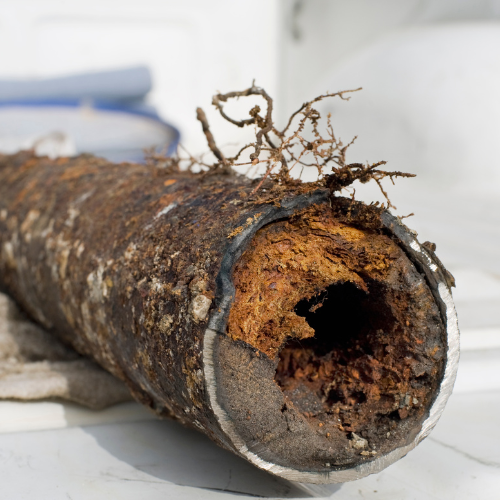What is Drain Cleaning?
Drain cleaning is a crucial aspect of home maintenance that involves clearing out clogs, debris, and buildup from your plumbing system to ensure water flows smoothly through your pipes. Over time, drains can become blocked due to various substances, such as grease, hair, soap scum, and food particles. When these materials accumulate, they can slow down or completely obstruct the flow of water, leading to potential plumbing issues, unpleasant odors, and even property damage.
How is Drain Cleaning Performed?
There are two primary methods used by professionals to clean drains: hydro jetting and snaking. Each method has its own benefits and is suited for different types of clogs and plumbing systems.
Hydro Jetting
Hydro jetting is a highly effective and modern drain cleaning method that uses high-pressure water to blast away debris, grease, and buildup from the inside of your pipes. A specialized nozzle is inserted into the drain, and water is forced through at pressures as high as 4,000 psi. This powerful stream of water scours the walls of the pipes, breaking apart clogs and washing away any remaining residue.
Advantages of Hydro Jetting:
Thorough Cleaning: Hydro jetting not only removes clogs but also cleans the entire pipe, preventing future blockages.
Environmentally Friendly: It uses only water, making it a chemical-free option.
Effective for Tough Clogs: It can tackle stubborn clogs, including tree roots and hardened grease.
When to Use Hydro Jetting:
For severe or recurring clogs.
When dealing with older plumbing systems that may have accumulated significant buildup.
Snaking
Snaking, also known as drain auguring, is a traditional method of drain cleaning that involves using a long, flexible metal cable with a corkscrew-like end to break up and remove clogs. The snake is manually or mechanically inserted into the drain and pushed through the clog. Once the clog is reached, the auger is rotated to break it apart, allowing the debris to be pulled out or pushed through the pipe.
Advantages of Snaking:
Less Invasive: Snaking is less likely to damage pipes, especially in older or fragile systems.
Cost-Effective: It is generally less expensive than hydro jetting.
Quick Fix: Effective for minor to moderate clogs.
When to Use Snaking:
For minor blockages, such as hair or small debris.
In older homes with delicate pipes that may not withstand high-pressure water.
Hydro Jetting vs. Snaking: What’s the Difference a summary
The main difference between hydro jetting and snaking lies in their approach to cleaning drains. Hydro jetting uses high-pressure water to clean the entire pipe, making it more effective for deep cleaning and preventing future clogs. Snaking, on the other hand, is more focused on removing specific blockages and may not clean the pipe as thoroughly.
While hydro jetting is more powerful and effective, it is also more expensive and may not be necessary for every clog. Snaking is a more affordable and less invasive option, but it may not completely solve the problem if the clog is severe or if there is significant buildup in the pipes.
How Often Should Drain Cleaning Be Performed?
The frequency of drain cleaning depends on several factors, including the age of your plumbing system, the type of usage, and the presence of any recurring issues. However, as a general guideline:
Annual Maintenance: For most homes, scheduling a professional drain cleaning once a year is sufficient to prevent major clogs and maintain the health of your plumbing system.
High-Usage Homes: If your home has heavy water usage or multiple occupants, you may need drain cleaning every six months.
Older Plumbing Systems: Homes with older plumbing may benefit from more frequent cleanings, as older pipes are more prone to buildup and blockages.
Tips to Reduce the Need for Drain Cleaning
While professional drain cleaning is essential for maintaining your plumbing system, there are steps you can take to reduce the need for frequent cleanings:
Avoid Pouring Grease Down the Drain: Grease solidifies as it cools, leading to clogs. Dispose of grease in a container and throw it in the trash.
Use Drain Screens: Install screens over your drains to catch hair, food particles, and other debris before they enter the pipes.
Be Mindful of What You Flush: Only flush toilet paper and waste down the toilet. Avoid flushing items like wipes, feminine hygiene products, and paper towels.
Regularly Flush Your Drains: Pour hot water down your drains regularly to help dissolve soap scum and flush out small debris.
Limit the Use of Chemical Drain Cleaners: While they may offer a quick fix, chemical drain cleaners can damage your pipes over time and are not effective for long-term maintenance.
Final Thoughts on Drain Cleaning
Drain cleaning is an essential part of maintaining a healthy plumbing system and preventing costly repairs. Understanding the methods of drain cleaning, such as hydro jetting and snaking, can help you make informed decisions about when and how to address clogs in your home. By following recommended practices and taking proactive steps to reduce the need for frequent cleanings, you can keep your drains flowing smoothly and extend the life of your plumbing system.

